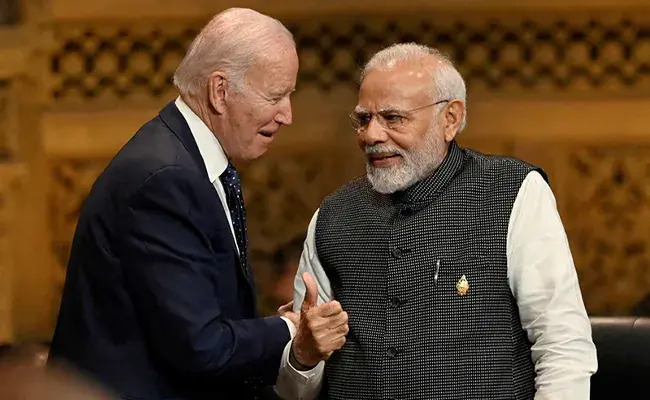The United States is currently facing its biggest challenge to global domination. This has been primarily influenced by various global developments, including the emergence of multiple poles, reduced economic competitiveness of the US, and diversified markets across Asia, among others. However, at its core, there lies an internal cause—the deviation from the original thought process of the US. Previously, the focus was on the idea that the US must be strong domestically to be strong internationally.
Plunging US dominance
After the pandemic and economic headwinds worldwide, the vulnerability of the US economy and geopolitical dominance has become apparent. Interestingly, China, an antagonistic economy and ideological rival, poses the biggest challenge to the US. This has led to new geopolitical dynamics in US policy-making, reflected in its strategic partnerships with countries like India, Australia, the Philippines, Japan, and South Korea.
Talking about India, the unprecedented economic growth, resilient economy, huge market and political stability has commended US effort with reciprocity. India-US relations have seen a continuous surge since the advent of this century. The only shift that has emerged in US’ perception of India is from a huge market to a strategic partner.
Under Biden administration this perception has reinforced. The most prominent architect behind this is Biden’s ‘once in a generation intellect’ Jake Sullivan, the NSA of United States of America. Around Presidential election in 2020, Jake Sullivan was based at the Carnegie Endowment for International Peace in Washington when he helped publishing a report ‘Making US Foreign Policy Work Better for the Middle Class’. The report addressed the long-standing issue of the US’s isolated foreign policy from its domestic one.
NSA Sullivan behind ideological foundation of Biden administration
Out of five recommendations, the fourth recommendation was to quash the above silos policy making. In doing so, it suggested to follow an approach towards a more cohesive network with the partner countries and allies. On the part of China, it recommends to manage strategic competition, countering Beijing’s effort towards technological and economic hegemony. Along with that, it suggested the development a robust digital ecosystem and safeguarding critical supply chains to bolster economic security.
This became the ideological foundation of Biden administration. Notably, this ideological foundation finds resonance with Indian administration’s current efforts. Probably that became a prominent reason that Jake Sullivan always voiced for evergreen and ever evolving relations with India.
The US-China competition primarily revolves around trade and technology, particularly in the semiconductor industry. The increasing digitization worldwide has created a growing demand for semiconductors, especially in countries with large populations and emerging economies like China and India. While China is one of the top exporters, it is heavily investing in semiconductor fabrication. However, it remains dependent on US architecture, which the US leverages. This was evident in the US ban on chip exports to China. The chip war has seen various developments, but the crux of the matter lies in the US restricting China from gaining technological advantage over it.
Bolstering relations between India and the United States
To counter China, the US is seeking India as an ally, as exemplified by the launch of iCET by Jake Sullivan and Ajit Doval in January of this year. This premise becomes even clearer with the signing of an MoU between the US and India for building resilient supply chains in the semiconductor sector through private partnerships, reducing India’s dependence on China and Taiwan.
Furthermore, the United States aims to establish a robust digital ecosystem and stable trade relations with cohesive markets in partner countries, with India being the most viable option. Indian markets have always welcomed US-based companies, while Indian companies have become important components of the US economy. The de-risking policy proposed by EU Commission Chief Ursula, accepted by the G7 in the recent summit, has also increased the likelihood of more rapid capital outflow from China, with India as a possible new destination. Additionally, the United States has now become India’s biggest trading partner. Concerning digital ecosystem, India’s performance is undoubtedly the best as also validated by the IMF.
This valuable partnership extends to another area of conflict with China—the Indo-Pacific region. Both countries desire a Free and Open Indo-Pacific based on a rules-based order. This shared objective is demonstrated through their active involvement in the Quad. While India faces the practical implications of Indo-Pacific challenges, the US seeks to enhance its defense partnership with India.
US making adjustments with ‘Make in India’
Although the US has eyed the Indian defense market for decades, it was in 2016 that India was officially recognized as a ‘Major Defense Partner’ by the US Congress. However, India is currently striving for an indigenous revolution in manufacturing, and the defense sector is no exception to that. Consequently, Washington has begun adjusting its approach as per ‘Make in India’, as evident by ongoing efforts by GE and HAL to establish a partnership for manufacturing jet engines in India.
All of this is happening due to the US’s changed approach towards India—an approach that differs from the previous sermonizing and dictating attributes of US foreign policy. Credit for this shift in the US’s perspective goes to NSA Jake Sullivan and his active involvement with one of the most intellectual NSAs, Ajit Doval. Yesterday, Jake Sullivan’s India visit came to an end. Sullivan has been in India for two days for finalizing agreements to be signed during Prime Minister Narendra Modi’s visit to the US. Both countries are focused on concluding a major defense deal between GE and HAL, as mentioned earlier. However, the solidity of the outcome is yet to be seen on June 21. Nonetheless, it is evident that the US-India partnership is on the brighter side of history.

